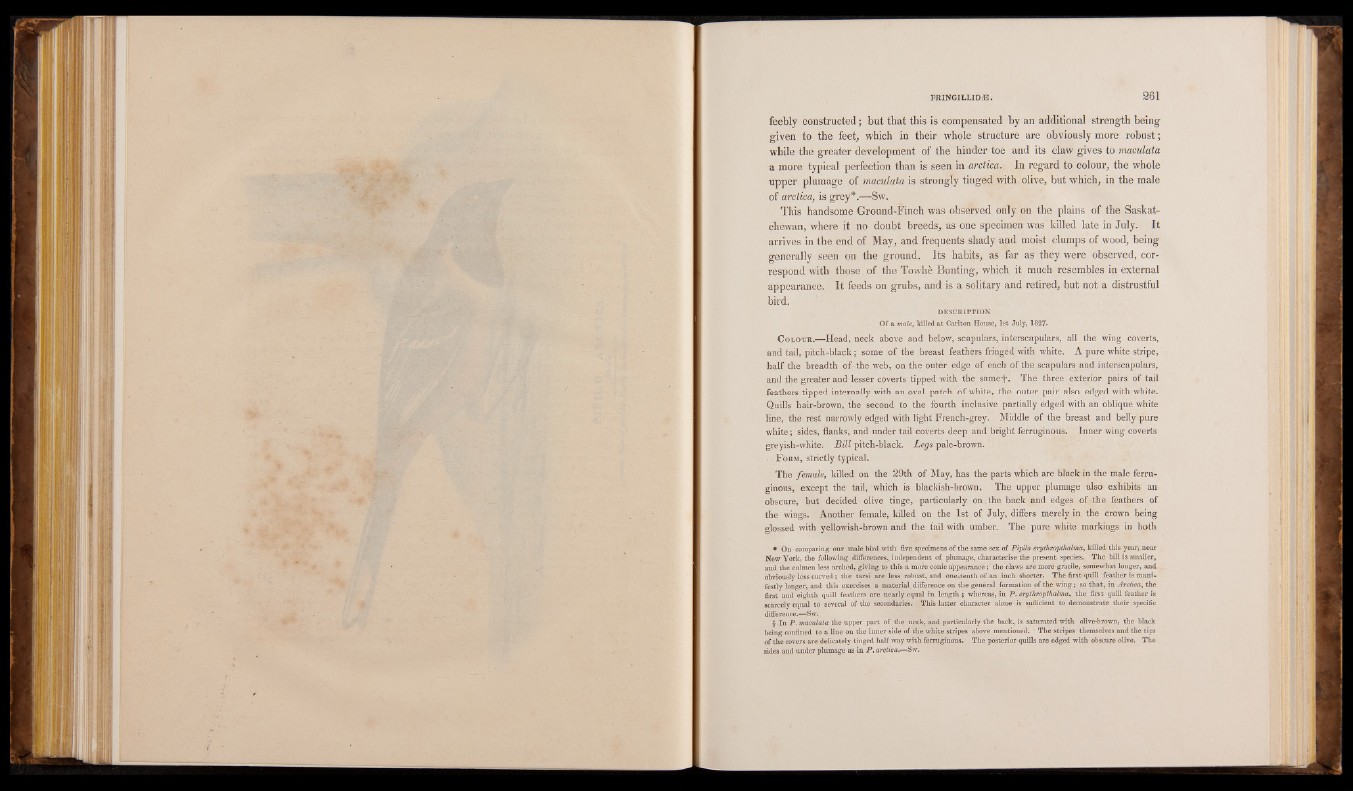
feebly constructed; but that this is compensated by an additional strength being
given to the feet, which in their whole structure are obviously more robust;
while the greater development of the hinder toe and its claw gives to maculata a more typical perfection than is seen in arctica. In regard to colour, the whole
upper plumage of maculata is strongly tinged with olive, but which, in the male
of arctica, is grey*.—Sw.
This handsome Ground-Finch was observed only on the plains of the Saskatchewan,
where it no doubt breeds, as one specimen was killed late in July. It
arrives in the end of May, and frequents shady and moist clumps of wood, being
generally seen on the ground. Its habits, as far as they were observed, correspond
with those of the Towhe Bunting, which it much resembles in external
appearance. It feeds on grubs, and is a solitary and retired, but not a distrustful
bird. DESCRIPTION
Of a male, killed at Carlton House, 1st July, 1827*
Colour.—Head, neck above and below, scapulars, interscapulars, all the wing coverts,
and tail, pitch-black; some of the breast feathers fringed with white. A pure white stripe,
half the breadth of the web, on the outer edge of each of the scapulars and interscapulars,
and the greater and lesser coverts tipped with the samef. The three exterior pairs of tail
feathers tipped internally with an oval patch of white, the outer pair also edged with white.
Quills hair-brown, the second to the fourth inclusive partially edged with an oblique white
line, the rest narrowly edged with light French-grey. Middle of the breast and belly pure
white; sides, flanks, and under tail coverts deep and bright ferruginous. Inner wing coverts
greyish-white. Bill pitch-black. Legs pale-brown.
• Form, strictly typical.
The female, killed on the 29th of May, has the parts which are black in the male ferruginous,
except the tail, which is blackish-brown. The upper plumage also exhibits an
obscure, but decided olive tinge, particularly on. the back and edges of the feathers of
the wings. Another female, killed on the 1st of July, differs merely in the crown being
glossed with yellowish-brown and the tail with umber. The pure white markings in both
• On comparing our male bird with five specimens of the same sex of Pipilo erythropthdlma, killed this year, near
New York, the following differences, independent of plumage, characterise the present species. The bill is smaller,
and the culmen less arched, giving to this a more conic appearance; the claws are more gracile, somewhat longer, and
obviously less curved; the tarsi are less robust, and one-tenth of an inch shorter. The first quill feather is manifestly
longer, and this exercises a material, difference on the general formation of the wing; so that, in Arctica, the
first and eighth quill feathers are nearly equal in length; whereas, in P. erythropthalma, the first quill feather is
scarcely equal to several of the secondaries. This latter character alone is sufficient to demonstrate their specific
differenceiT-Sw.
f In P. maculata the upper part of the neck, and particularly the back, is saturated with olive-brown, the black
being confined to a line on the inner side of the white stripes above mentioned. The stripes themselves and the tips
of the covers are delicately tinged half way with ferruginous. The posterior quills are edged with obscure olive. The
sides and under plumage as in P. arctica.—-Sw.